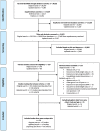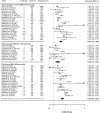The association between maternal body mass index and child obesity: A systematic review and meta-analysis
- PMID: 31185012
- PMCID: PMC6559702
- DOI: 10.1371/journal.pmed.1002817
The association between maternal body mass index and child obesity: A systematic review and meta-analysis
Abstract
Background: There is a global obesity crisis, particularly among women and disadvantaged populations. Early-life intervention to prevent childhood obesity is a priority for public health, global health, and clinical practice. Understanding the association between childhood obesity and maternal pre-pregnancy weight status would inform policy and practice by allowing one to estimate the potential for offspring health gain through channelling resources into intervention. This systematic review and meta-analysis aimed to examine the dose-response association between maternal body mass index (BMI) and childhood obesity in the offspring.
Methods and findings: Searches in MEDLINE, Child Development & Adolescent Studies, CINAHL, Embase, and PsycInfo were carried out in August 2017 and updated in March 2019. Supplementary searches included hand-searching reference lists, performing citation searching, and contacting authors. Two researchers carried out independent screening, data extraction, and quality assessment. Observational studies published in English and reporting associations between continuous and/or categorical maternal and child BMI or z-score were included. Categorical outcomes were child obesity (≥95th percentile, primary outcome), overweight/obesity (≥85th percentile), and overweight (85th to 95th percentile). Linear and nonlinear dose-response meta-analyses were conducted using random effects models. Studies that could not be included in meta-analyses were summarised narratively. Seventy-nine of 41,301 studies identified met the inclusion criteria (n = 59 cohorts). Meta-analyses of child obesity included 20 studies (n = 88,872); child overweight/obesity, 22 studies (n = 181,800); and overweight, 10 studies (n = 53,238). Associations were nonlinear and there were significantly increased odds of child obesity with maternal obesity (odds ratio [OR] 3.64, 95% CI 2.68-4.95) and maternal overweight (OR 1.89, 95% CI 1.62-2.19). Significantly increased odds were observed for child overweight/obesity (OR 2.69, 95% CI 2.10-3.46) and for child overweight (OR 1.80, 95% CI 1.25, 2.59) with maternal obesity. A limitation of this research is that the included studies did not always report the data in a format that enabled inclusion in this complex meta-analysis.
Conclusions: This research has identified a 264% increase in the odds of child obesity when mothers have obesity before conception. This study provides substantial evidence for the need to develop interventions that commence prior to conception, to support women of childbearing age with weight management in order to halt intergenerational obesity.
Conflict of interest statement
The authors have declared that no competing interests exist.
Figures



Comment in
-
Maternal weight status before pregnancy is strongly associated with offspring weight status in childhood.Evid Based Nurs. 2020 Jul;23(3):91. doi: 10.1136/ebnurs-2019-103178. Epub 2019 Sep 19. Evid Based Nurs. 2020. PMID: 31537624 No abstract available.
References
-
- World Health Organization. Overweight and obesity. Geneva: World Health Organization; 2018. [cited 2018 Jul 2]. http://www.who.int/mediacentre/factsheets/fs311/en/.
-
- Ng M, Fleming T, Robinson M, Thomson B, Graetz N, Margono C, et al. Global, regional, and national prevalence of overweight and obesity in children and adults during 1980–2013: a systematic analysis for the Global Burden of Disease Study 2013. Lancet. 2014;384(9945):766–81. 10.1016/S0140-6736(14)60460-8 - DOI - PMC - PubMed
Publication types
MeSH terms
Grants and funding
LinkOut - more resources
Full Text Sources
Medical
Miscellaneous

